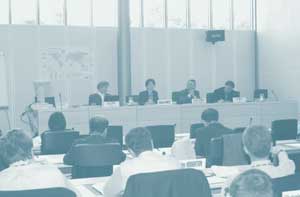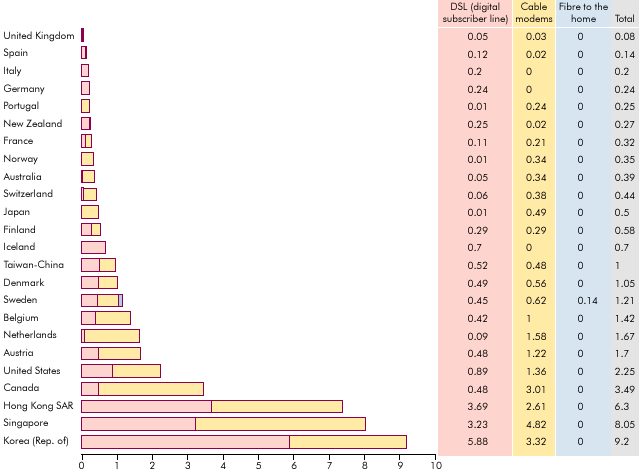

The term "broadband" conjures up visions of opportunities for individuals, compa nies and nations. But what does it mean? And what are these opportunities? How can we manage its development and uptake to maximize the potential benefits? How soon can a broadband future be realized? Perhaps the main reason for the interest and uncertainty is that broadband issues cut across previously separate industries of telecommunications, broadcasting, and information technology (IT). Therefore, experts from each of these converging sectors know only part of the story and need to be brought together to get the synergies from combining their knowledge.
ITU's recent workshop on the "Regulatory Implications of Broadband" brought experts together to canvas the range of issues, perspectives and expectations on this complex topical issue. The workshop (Geneva, 2-4 May 2001) was the fourth in a series to be organized by the Strategy and Policy Unit under the ITU New Initiatives Programme, and was chaired by Deborah Hurley of Harvard University (United States). Mohamed Sharil Tarmizi of the Malaysian Communications and Multimedia Commission gave the keynote address, followed by presentations. Nae-Chan Lee (Republic of Korea) spoke on broadband service operational issues; Damien Geradin, University of Liege (Belgium), covered regulatory issues of infrastructure; and Mark Naftel of Norton Rose highlighted the market implications of technological neutrality (www.itu.int/broadband).
Apart from the briefing paper that ITU had prepared for the workshop, along with a paper on government strategies to encourage broadband, the discussion was also based on specially commissioned case studies covering Australia, Italy, Malaysia and South Africa. Experiences of other countries and regions, notably Canada, India, the Republic of Korea and the European Union were another important contribution. Don MacLean (Canada), former Head of the ITU Strategic Planning Unit, led a roundtable discussion on the possible future role of ITU in broadband.
There is no internationally agreed definition of broadband. The term is a moving target, and generally refers to a capacity to transmit information electronically. It allows for transmission of large amounts of information for bandwidth-hungry technologies and applications such as full-motion video or CD-quality audio. These applications are available on narrowband networks, albeit with slow download times or low quality.
Twenty years ago, anything faster than basic rate integrated services digital network (ISDN), which offered speeds of up to 144 kbit/s, might have been considered broadband. Over the last five years, as broadband networks based on either digital subscriber line (DSL) or cable modem technology have slowly been deployed, speeds of around 250 kbit/s and upwards are generally regarded as broadband. Strictly speaking, according to ITU-T Recommendation I.113, broadband means transmission capacity that is faster than primary rate ISDN, at 1.5 or 2.0 Mbit/s. For the moment, these speeds are rarely offered in interactive services to individual users (though higher speeds may be available for downloading than for uplinking).
A recent study carried out by the Canadian National Broadband Task Force notes that national definitions range from
as low as 200 kbit/s to as high as 30 Mbit/s among the 14 countries studied. As these speeds become commonplace, no
doubt the definition will continue to evolve.

Strategic Planning Workshop on the "Regulatory Implications of Broadband"
(ITU 010047)
Such definitions focus on broadband as a technical issue rather than taking a service-oriented approach. The workshop itself agreed that it was not necessary to define broadband in technical terms in order to engage in meaningful and productive debate. An alternative approach to defining broadband would be to state a minimum level of functionality, rather than a minimum speed. A service-oriented approach would nominate a particular application or service as the benchmark. For instance, any network capable of carrying full-motion video would fit the popular image of a broadband network. A service-focus approach is consistent with the argument that governments should stop focusing on transmission rates and instead focus on the services that are needed or wanted in each area and then determine what technology is required for those services.
Broadband networks can be used for communication of all kinds, for example, voice, data, radio and television, and can take many forms such as fibre, copper, wireless and satellite. Thus, traditional regulatory definitions may be overtaken by technological convergence. Issues such as cross-media competition, access to networks, and technology-neutral regulation place broadband at the centre of divergent policy and regulatory debates. What role should policy-makers play in stimulating investment in broadband networks? Do converged networks require converged regulatory structures?

Deborah Hurley
Photo: A. de Ferron (ITU 010046)
The development of broadband is a global challenge and no single country or region can claim to have all the answers. It was clear from the workshop discussions that the transition to broadband could well pose new challenges to regulators that may require a radically different approach to how they do their jobs:
– Although most developed country markets already have competition in services provision, competition at the level of network provision has been slower to materialize, especially in the local loop. There are signs that broadband networks, because of their high barriers to entry and ability to deliver multiple services via the same point of entry, may have a tendency towards monopoly provision, at least for residential consumers. Consequently, regulators may need to review whether existing market structures are capable of delivering the competitive benefits they are seeking, and what safeguards might be necessary.
– At least in the early stages of network roll-out, broadband is costly to provide, especially in low-density rural areas and on a nation-wide basis. Consequently, governments may find that policy objectives, such as balanced regional development, are thwarted. Traditional concepts of universal service may also need to be revisited in a broadband future.
– Telecommunication tariffs have traditionally been charged, in most countries, by the minute, by the mile and by the megabyte (i.e., according to usage). In a broadband world, with higher entry costs but minimal incremental costs, other types of tariff structures might be more appropriate, for instance to offer "always on" services. Where regulators have applied controls to retail and interconnection tariffs on the basis of per minute charges (e.g., price cap regulation), a new approach might be necessary.
– In most countries, broadcast services such as television and radio have traditionally been regulated in a different manner from switched services such as telephone or fax. Equally, within the telecommunications world, voice services have often been treated differently to data services. Broadband blurs these distinctions and is forcing a move towards converged regulatory structures. Malaysia is one country that has changed its regulatory framework in order to accommodate convergence.
The consensus reached by the workshop was surprising not only because the participants were such a disparate group, but also because the topics on which agreement was reached were unexpected. There was consensus that:
– content is extremely important to market development and to national policy objectives;
– competition is not the be-all and end-all regulatory framework as it may have been perceived in the 1990s — national development, and access and equity issues may dominate in future infrastructure debates, just as they did in the past;
– it is not necessary to have a converged regulator to deal with issues of convergence. In fact, there was almost no debate over the possible need for a converged regulator. The content, style and consistency of regulation are what matter — not whether they are achieved by a single regulator or several regulators acting in concert.
There was little, if any, consensus on technological neutrality.
Discussion of the broadband market must be made not only without a concrete definition, but also with no hard data as to what is driving demand. It appears that the market for broadband to the home is driven by the demand for interactive games, Internet and interactive television. There is even less data on the drivers for commercial broadband connectivity, though Internet and e-commerce applications are undoubtedly important.
Residential demand for broadband is largely for services that already exist (for example, television, Web browsing and e-mail) that could now be quicker (faster response times), more reliable, more convenient, and possibly cheaper. But the search continues for a `killer' broadband application — an application that most consumers feel that they must have and that they cannot have without broadband. The three candidates that are put forward most often are:
– High-speed Internet access (permitting, for instance, quick downloading of higher-quality video clips or MP3 audio files).
– Interactive digital television permitting delivery of multiple channels with convenient subscriber access control, and some measure of video-on-demand, or a near equivalent.
– Interactive video games (see Waiting for broadband).
It may be that these three potential killer applications are effectively the same: multimedia entertainment. In the United Kingdom, for instance, the otherwise delayed uptake of broadband is being led by the demand for digital television, with 28 per cent of consumers receiving this service in April 2000. In the Republic of Korea, by contrast, it appears to be high-speed Internet delivery by DSL that is driving the residential broadband market (see The Republic of Korea's success with ADSL).
A broadband future (perhaps in the guise of an information society) is seen as a national objective by many countries, such as Canada, Denmark, Japan, Malaysia and Sweden.
Some of the most pressing national objectives for broadband relate to content. Content in national languages is seen to be important to both maintaining a national identity, and becoming a knowledge economy (for example, Malaysia, Singapore and South Africa). There seems to be concern that the Internet is used too much for entertainment rather than for serious pursuits of education, and on-line democracy (e-government). Other concerns indicate that the lack of quality content is stifling the growth of the industry. This camp argues that the benefits of broadband will emerge even if the driver of connectivity is access to entertainment (e.g., Australia and Italy). Denmark seems to have one foot in each camp by trying to grow the market for broadband through e-government initiatives.
A clear national vision should also prevent a downtown-centric approach in which wealthy areas of high-density use are catered for first. What is preferred is an approach that identifies needs and focuses on satisfying them. The greatest needs for broadband connectivity may be to overcome the tyranny of distance (e.g., telehealth for remote communities — Australia and Canada) and the need for both space and high-tech applications (e.g., computer-aided design in heavy industry). Having said this, there was a lot of support at the workshop for the efforts of Malaysia, which has established a Multimedia Super Corridor with high bandwidth broadband connectivity to be a hotbed of broadband development. That corridor is part of an integrated national strategy rather than a simple downtown-centric approach to the issue (see Malaysia's broadband future).
Figure 1 – Broadband deployment, suscribers per 100 inhabitants (December 2000)

Source ITU/OECD (2001)
There appears to be little understanding of what regulatory frameworks enhance the supply and uptake of broadband. While there are figures on the residential market penetration, and ITU collects data on national regulation, putting the two together to argue that a particular framework promotes broadband is a leap of faith few are prepared to make. The Republic of Korea leads the world with around one third of households connected to broadband (see Figure 1), either by cable modems or by asymmetric digital subscriber lines (ADSL). Both ADSL and cable modems are capable of supporting close to full-motion video that enables entertainment as well as information garnering and access to on-line democracy (e-government). The Korean success story can be largely explained by:
– Demand driven by a cultural predisposition to invest in education (for example, Internet for accessing information).
– Supply, facilitated by 90 per cent of households being within the range of ADSL (4 km).
– A competitive market-place in which many consumers can choose between ADSL or cable modems and in which many can also choose additional solutions, such as satellite or local area network (LAN) delivery of broadband.
– Affordability, enhanced by flat-rate tariffs.
– A centralised approach to developing the broadband market.
Canada also has a relatively centralised plan for broadband and a competitive market, but otherwise it has little in common with the Republic of Korea. The United States does not have a centralised plan and few consumers have a choice between broadband offerings. So, even at this general level, it remains difficult to see what determines a country's broadband success. Neither GDP per capita, nor level of industrialization, are good predictors (for example, Germany and the United Kingdom have a lower level of broadband penetration than Portugal).
Moreover, one of the most popular regulatory issues, that of unbundling the local loop, is not so clearly related to broadband success. The Republic of Korea has not yet unbundled, but other economies that are not doing nearly so well have done so. Nor is there any clear link between unbundling and network investment. While it may be intuitively attractive to argue that allowing competitors to access the incumbent's local loop will deter investment in improved local loops, this does not seem to be the case for either the incumbent or new operators. Therefore, while it may be provocative to argue that unbundling the local loop may be tantamount to accepting that there will be no competition at the network level, to affirm so appears to be wrong.
While it might have been anticipated that, given the difference in perspectives over the issue of technological neutrality there would be heated debate, in practice the issues were more those of non-discriminatory regulatory treatment. For instance, some participants expressed concerns that requirements to unbundle the local loop were being applied to public telecommunication operators but not to cable TV operators. This leads to inconsistencies between markets. Similarly, it was observed that, among ITU Member States, provision of cable TV services by telephone operators is generally much more liberalized than provision of telephone services by cable TV operators.
Is there a possible role for ITU in helping to promote broadband networks? The main area for ongoing ITU work relevant to broadband is likely to be on standards development, especially in areas like multimedia services, quality of service and billing. ITU stewardship of scarce resources, such as spectrum or numbering plans is also highly relevant in this respect. In the Development Sector, advice to regulators on development of appropriate structures and the identification of future regulatory issues is likely to prove valuable. ITU can also play a valuable role in information sharing, especially among regulatory agencies. The main impact of broadband is likely to be convergence. Therefore, there may be a need to undertake in-depth analysis of the various forms and market implications of convergence in order to further shed light on the regulatory implications of broadband. ––
| This article is based on ITU's recent Strategic Planning Workshop on the "Regulatory Implications of Broadband". It is followed by a series of short "stories" selected from a "Briefing paper", prepared by Lucy Firth and Tim Kelly, Chief of ITU's Strategy and Policy Unit. |
Waiting for broadband
While it may be true to say that, as yet, no single ap plication has emerged that makes broadband a "must-have" service for consumers, there are many actual and potential applications for which broadband is a "must have" for suppliers. Indeed, because the arrival of broadband has been slower than was predicted by some, the commercial viability of the first-movers in these markets has been seriously challenged. Here are just three examples of the many applications that are "waiting for broadband".
Video games. The latest games consoles, such as Sony's Playstation 2 or Microsoft's X-box, come ready armed with Internet connections, DVD drives and high-powered graphic chips which make even top of the range personal computers seem slow. However, gamers are amongst the most demanding interactive users. For them, even the slightest delay between a signal being sent and a response being shown on screen is intolerable. So, while many video-game companies see the Internet as a way of earning new revenues, today's narrowband networks just won't cut it. A high-speed broadband connection could make the business models of companies such as SegaNet (www.sega.net) actually make sense. For gamers, a broadband connection opens up the chance of playing against friends and unknown rivals and also offers a chance to try out new games before purchasing them. For suppliers, the idea of pay-per-play, as well as monthly subscription income (SegaNet charges USD 21.95 per month) promise to provide a more even revenue stream than the normal pre-Christmas rush for the latest software and consoles. Short films. In an entertainment world that is dominated, on the one hand, by Hollywood blockbusters and on the other, by television, it is not easy for makers of short films to get airplay. Short films fit within the 30 seconds to 30 minutes category and may be animated or real-life. Many offer short visual jokes or spoofs of advertisements. While the Internet, as potentially the largest video-library in the world, provides an obvious outlet for short films, viewers with 56 kbit/s may still end up spending many minutes, if not hours, downloading the film of their choice. When it arrives, the picture might be small and the quality, for streaming media, poor. This turns off users, which turns off potential advertisers. Broadband promises to cut through the log-jam and is a godsend to companies like AtomFilms (www.atomfilms.com) which have been waiting patiently since 1998 for it to arrive. In the meantime, many of its competitors have gone bankrupt and AtomFilms itself has only survived by using the Internet as one of many distribution channels. But every new broadband subscriber increases its potential market.
Application service providers. The basic idea behind an application service provider (ASP) is that, instead of buying packaged software on a CD-ROM, subscribers would rent it and pay for it either on a "pay-as-you-go" or on a flat rate monthly fee basis. Similarly, instead of hosting your own website, you could outsource this mission-critical task. For the software company, selling via an ASP offers a new marketing channel, allowing potential users to try out software without heavy up-front costs but without the possibility to make an illegal copy before returning it to the vendor. For the user, buying from an ASP means that you always have the very latest release of the software available and an online help facility when problems arise. Market leaders in the business include Usinter-networking (www.usi.net) and Loudcloud (www.loudcloud.com). But perhaps the biggest splash to date was made by Microsoft's announcement of its .Net strategy, which promises to change the way software is sold and used by making it available over the Internet from anywhere in the world. Like the other applications listed above, such a move from local to distributed- information storage depends crucially on being able to have equivalent access speeds over a wide-area network to those enjoyed over a local area network. Again, that sounds like a job for broadband. –– |
There is a long history of direct govern ment involvement in infrastructure projects. The origins of both the telegraph and the telephone networks are tied up with the State in most, though not all, countries. Governments also played an important early role in establishing satellite networks. Governments in Europe ensured that GSM was adopted as a regional standard for cellular mobile. The US government funded the development of the Internet during its early formative years. But times have changed. So, what is the proper role of government in a market characterized by open entry and competition? Should a government play a role in promoting broadband, even if it risks favouring one firm, or selecting one technology, over another? Equally, can a government afford not to intervene if its industrial competitors and trade partners choose to do so?

Broadband networks can be used for communication of all kinds, for example, voice, data, radio and television, and
can take many forms such as fibre, copper, wireless and satellite
Photo: PhotoDisc (ITU 0100051)
Because the history of competition in telecommunications is still so recent, and because the opportunity to build a new network comes along so rarely, there is no real precedent for addressing these questions. But there are certainly signs that governments are not willing to sit on the sidelines:
– In Europe, the European Commission took the unusual step, in December 2000, of issuing a `Regulation' in order to force the pace of local loop unbundling.
– In the United States, government funds have been directed to creating a "next-generation Internet".
– In Singapore, the government has played a leading role in creating the "Singapore One" nationwide broadband network not only as a way of delivering its services to its citizens, but also as a way of establishing a lead for the city state in the global information economy.

No single "killer application" has yet emerged to drive broadband consumer demand. One candidate
application often put forward is interactive digital television permitting delivery of multiple channels with
convenient subscriber access control
Photo: PhotoDisc (ITU 010050)
At the regional and city level too, local government has sometimes taken on a more active role as a potential supplier of broadband services. In Stockholm, for instance, a company called Stokab AB, which is jointly owned by the City of Stockholm and the County Council, is building and operating a fibre-optic network, on an operator-neutral basis. It acts as a wholesaler, offering dark fibre to operators that provide services to business and residential customers. As of early 2001, it provided 3500 km of fibre-optic cable (with 400 000 km of individual fibres). The cities of Concord (Massachusetts), Lynchburg and Palo Alto in the United States have taken a similar approach. City and regional development agencies have sometimes taken the initiative in creating science parks or other zones (see Malaysia's broadband future), which are ready-cabled for broadband access, in an attempt to attract high-tech investors. One advantage that city governments sometimes have is control of rights of way and access to homes and business, for instance via water or sewerage pipes that can be used for laying cable.
But the early signs are that broadband may not take off as quickly as might have been hoped or expected. Access technologies such as digital subscriber line (DSL) or cable modems, have been deployed only slowly, partly due to technical difficulties but also because the price was often prohibitive for consumers. Unbundling of the local loop has been delayed by regulatory and pricing disputes. No single "killer application" has yet emerged to drive broadband consumer demand. One of the applications that might have filled this role — free music on-demand delivered by services such as Napster — has been declared to infringe copyright.
The worst news of all for those promoting broadband is the fact that, since the dot.com stock market bubble burst in March 2000, an estimated USD 1 trillion has been wiped off the share values of firms in the technology, media and telecommunications sector. That precipitous decline has left venture capital firms, who might otherwise be expected to underwrite the investment in broadband networks, extremely wary of long-term investment. There are many competing demands on a public telecommunication operator's purse strings — bidding for third generation (3G) mobile licences, entering foreign markets, and diversifying through acquisitions — so that unless there is a strong competitive push to invest in broadband networks straight away, the temptation will be to wait until the economic climate looks better.
At the start of the new millennium, following a period of sustained economic expansion driven by information and communication technologies (ICT), the world is once again facing recession. In previous recessions, governments have sought to kick-start economic growth by infrastructural investment projects. Could they, would they, should they do so again? ––
Competition between mediaAT&T, AOL and the FCC go head to head on the open access issue
Photo: PhotoDisc (ITU 010049)
The open access lobby continues to fight in local and state courts on the grounds that competition will be good for the industry and the consumer by promoting growth and interconnectivity. The counter argument is that the roll-out to date has been extensive, has directly benefited consumers by enabling the service, and has indirectly benefited the industry by promoting innovation. Without the roll-out, there would be no network, no services and no prospect of competition. AT&T has threatened that those cities that impose burdensome open access regulations will be the last to see broadband. The FCC has been pleased by the agreements with Road Runner and with Mindspring, which they see as evidence that the nascent industry is opening up under market conditions. Further evidence of competitive service provision is that digital television services are available by satellite. Digital direct-to-home satellites are pulling ahead of digital cable television. The benefits include the element that coverage is instant across an entire region rather than rolled out on a neighbourhood by neighbourhood process. While both satellite and cable offer digital video ser vices, interactive services are more prevalent among satellite. Therefore, while prospective entrants to the market are fearful that they will not have access in time to build the market in a way that suits their companies, the FCC has decided against intervention. –– |

Malaysia began preparing for a broadband future as early as 1994 when it established the National Information Technology Commission (NITC) and set about identifying possible barriers to an IT-led leapfrog towards developed-nation status. A major finding was that too many regulations (and too many regulators) did not suit the needs of industry. Subsequently, the Communications and Multimedia Commission (CMC) was established in 1999 under the Communications and Multimedia Act to regulate the activities of:
– Network facility providers, regardless of their transmission medium.
– Network service providers, regardless of the network technology.
– Application service providers, regardless of whether the service is voice, data, broadcast, video, radio, etc.
– Content applications service providers, regardless of transmission medium and application.
The CMC can therefore be regarded as a converged regulator with a technologically neutral stance.
However, there are legacy regulations that are not yet consistent with a totally converged environment. For instance, universal service obligations relate only to basic telephony, and the interconnectivity regime does not require local loop access to applications other than telephony. The main regulatory reform expected over the next two years is a complete review and modification of this legacy regulation.
Malaysia's obsession with all things to do with multimedia means that preparation for a broadband future has involved much more than changing the regulatory framework. The seedbed is the Multimedia Super Corridor (MSC) with its totally planned `Silicon Valley' environment, in a manicured tropical garden setting. The business hub of Cyberjaya (jaya is Malay for prince) and the neighbouring new national administrative capital of Putrajaya have universal broadband connectivity, smart houses and the world's first multimedia university. At present, 40 of the top 50 "world class companies" that Malaysia sought to attract have a presence in the MSC.
At a national level, the government has established several programmes to kick start broadband use by individuals and companies, including:
– E-services: bringing access to government services to individuals and companies.
– E-labour market: where the government acts as an agent bringing together workers and companies.
– E-procurement: where government agencies buy common requisites.
– Smart schools: targeting the one-third of the Malaysian population of school age.
These programmes are currently being piloted in the MSC. But, there are many barriers to overcome before a national roll-out of broadband-based services will succeed. While the broadband backbone is in place, connectivity to homes and small businesses is still via twisted copper wires that will not carry broadband capacity. With no history of cable television, cable modem access is an unlikely future. Therefore, with the incumbent's local loop not unbundled, companies seek wireless solutions for the last mile. These solutions are hampered by lack of spectrum allocation in ranges far enough away from 2.4 GHz to be robust in tropical weather.
In some states, 25 per cent of households do not have mains electricity, and 35 per cent of households do not have a telephone. Although there are some community telephone and Internet services, some citizen live as many as three days walk from the nearest telephone!
Source: ITU Malaysia country case study, available at www.itu.int/broadband ––

Since the introduction of Internet services in 1994, the Republic of Korea has experienced an explosion in the size of the Internet service market that had grown to 19 million users (38 per cent of the population) by December 2000. This has been followed by a boom in broadband Internet access.
With fierce competition in the broadband Internet access market, the number of subscribers reached more than 4.6 million in February 2001 (one in every four households). Although broadband access via cable television networks came first, with the launch of a cable modem service by Thrunet in July 1998, it is asymmetric digital subscriber line (ADSL) services that have taken off faster. By February 2001, the majority of broadband subscribers (almost 3 million) were using ADSL, with Korea Telecom supplying more than 70 per cent of the market. Next in popularity is broadband Internet via cable television networks (1.5 million subscribers).
| Behind this successful uptake of broadband Internet, one of the fastest growth rates in the world, lies the Government's strong policy drive. This involved drawing up a long-term plan for broadband Internet infrastructure back in 1995, and implementing various information projects aimed at creating demand for ICT services |
Here, thanks to its early start, Thrunet controls just over half the market but there are at least six companies offering services. Local area network Internet services to larger apartment complexes and satellite-based Internet services account for the rest of the broadband Internet subscribers.

ITU TELECOM ASIA 2000 at the Hong Kong Convention and Exhibition
Centre
Photo: A. de Ferron (ITU 004404)
The pattern of household residents in the Republic of Korea can explain, in part, the success of ADSL. More than 90 per cent of households live within 4 km of a local exchange. Most offices and half of the households, about 7.5 out of 15 million, are in apartment complexes. With short distances, not only is one of the main disadvantages of ADSL technology avoided, but also economies of scale are achieved in providing ADSL service using fibre cable.
Behind this successful uptake of broadband Internet, one of the fastest growth rates in the world (see Figure 1), lies the Government's strong policy drive. This involved drawing up a long-term plan for broadband Internet infrastructure back in 1995, and implementing various information projects aimed at creating demand for ICT services. For example, providing all primary and secondary schools with free Internet access. Moreover, competition in the broadband Internet access market spurred an aggressive tug-of-war among facility-based service providers utilizing different access technologies. The explosive growth in subscribers is attributed to competition between multiple operators and services, which has had the effect of lowering prices even during the early phase of market development.

One application that has proved popular for broadband subscribers, perhaps surprisingly, is voice telephony. Although, telephone calls only require a fraction of the bandwidth offered by a broadband connection, the flat-rate pricing structure makes it a popular application when combined with a technology such as "Voice over DSL". Some Korean service providers, notably Serome Technology (Dialpad.com), offer domestic IP telephony free of charge, at least initially. The growth of broadband has coincided with a rapid expansion in the number of IP telephony subscribers, who numbered around 7.6 million in the country by year-end 2000 (see the ITU IP telephony country case study, available at www.itu.int/wtpf/casestudies/korea.pdf).
In order to further drive the growth in the broadband Internet access market, the government was scheduled to
implement open access for ISPs and unbundling of the local loops of incumbent public telecommunication operators in
early 2001. ––

As DSL offers the greatest potential for broadband access in the near future for both small-and medium-sized enterprises (SME) and residential consumers, BT's network is considered too valuable a resource to leave in monopoly control. The Office of Telecommunications (Oftel), the United Kingdom's regulator for the telecommunications industry, consequently decided to mandate that BT open its local loop to competitive service providers, even though BT itself was planning to introduce ADSL services. Oftel considered two options to achieve unbundling:
– BT would make local access lines available to other operators. This would give operators the flexibility to create their own access offerings choosing when and where to roll out, and the technology with which to upgrade the lines.
– Service providers and operators could access customers over BT's upgraded network. This enables access to a number of customers without the need for significant investment in infrastructure, but is less flexible than the first option.
On the balance of cost-benefit analyses, the first of these options was adopted. The operator purchasing the service would be able to install equipment in the local exchange (as BT makes space available) and on customer premises. There is to be no limit on the technology used to upgrade the loop other than the adherence to certain technical standards. Competitive operators should be able to offer services on or before 1 July 2001 under the following conditions:
– Unbundled loops and collocation will be available to operators with interconnection rights and obligations.
– Loops are available at a cost-based price, allowing for reasonable profit.

Access technologies such as digital subscriber line (DSL) or cable modems, have been deployed only slowly, partly due to technical difficulties but also because the price was often prohibitive for consumers
Photo: PhotoDisc (ITU 000081)
By January 2001 it was apparent that the plans to unbundle the local loop were failing, despite BT's attempts to separate ownership and service delivery over the local loop, and even though BT announced that it would commence collocation in April 2001 rather than July, to enable competitors to establish broadband equipment in its local exchanges. When the first 25 of BT's exchanges were open to collocation bids, its rivals placed orders for only 14 of them. The prices proposed by BT and the loss of investor confidence in the telecommunications sector apparently had a dissuasive effect.
In February 2001, the UK Government decided against spending GBP 1 billion (USD 1.43 billion) to upgrade telephone exchanges to make them compatible with DSL. It had been anticipated that the Government would pay for the upgrade of the exchanges in order to resuscitate the ailing plans for "broadband Britain", in the face of BT's delay in unbundling of the local loop. At issue is the question of who should pay for the upgrade of the exchanges. The upgrade is needed because voice over DSL (VoDSL), as a digital signal occupies only part of the DSL channel and so must be treated before connection with the PSTN. ––